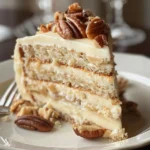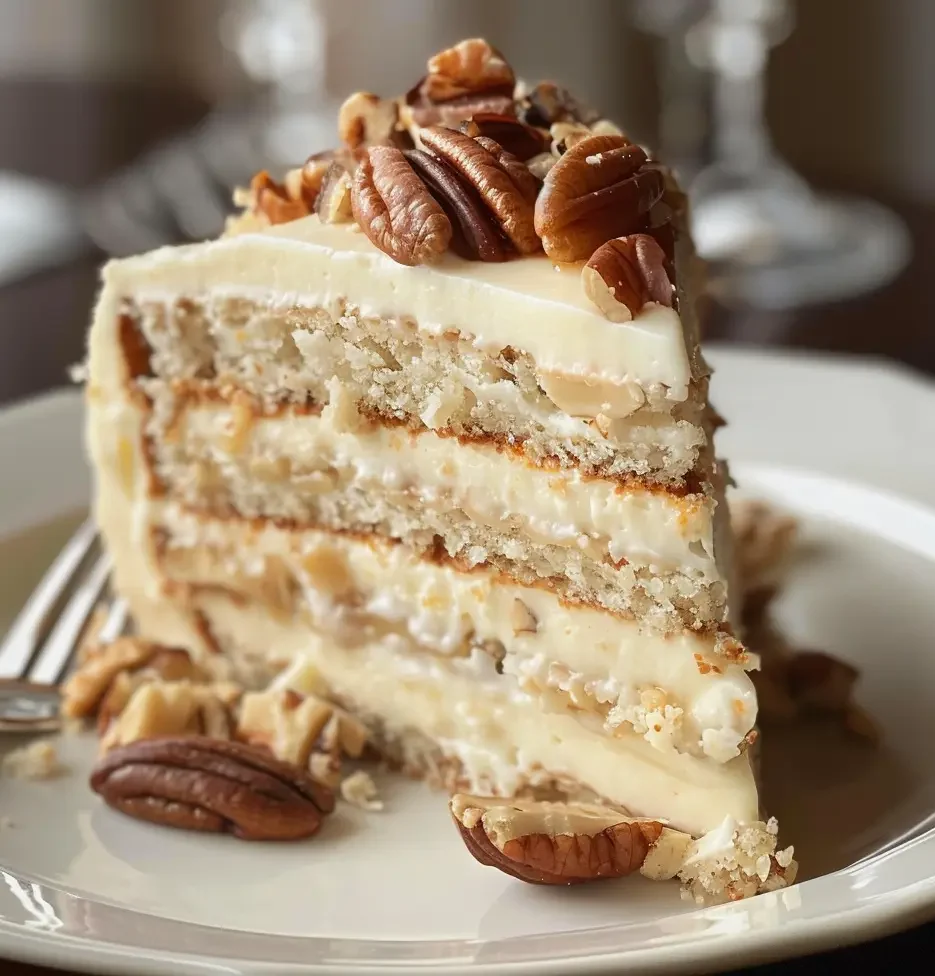The first time I made this Snowy Bavarian Bliss Cake was for my mother’s birthday last winter. We were expecting a small gathering of family, but a surprise snowstorm left us all happily stranded at home with nothing but good company, warm coffee, and this magnificent cake taking center stage on my worn oak dining table. The way the coconut shreds scattered across the frosting mirrored the snow piling up outside my kitchen window created a moment of pure magic I’ll never forget.
Every time I make this cake now, I’m transported back to that evening—laughter echoing through my small dining room, the warm glow of candlelight, and the collective sighs of delight as everyone took their first bite. Some recipes become special not just for how they taste, but for the memories they hold. This one certainly does both.
A Taste of Tradition with a Personal Twist
This cake holds a special place in my heart because it reminds me of the traditional German tortes my grandmother used to make. While her recipes were far more complex and time-consuming, I’ve adapted this version to bring those same wonderful flavors to your table without requiring professional baking skills.
The combination of light, fluffy cake layers with the rich, textured frosting creates a beautiful contrast that makes each bite interesting. After testing this recipe numerous times (my neighbors have become very willing taste-testers), I found that using buttermilk instead of regular milk gives the cake an incredible tenderness that perfectly complements the nutty, caramel-like frosting.
What You’ll Need
White cake mix: The foundation of our cake; I’ve tested making this from scratch, but honestly, a quality cake mix delivers consistent results while saving precious time.
Buttermilk: Adds tanginess and creates a more tender crumb than regular milk; if you don’t have buttermilk on hand, add a tablespoon of lemon juice or white vinegar to regular milk and let it sit for 5 minutes.
Vegetable oil: Creates moisture that stays locked in during baking; I’ve tried butter, but oil gives a consistently moister texture.
Egg whites: Provide structure while maintaining the snow-white color; save those yolks for the frosting!
Vanilla extract: Use pure rather than imitation if possible; the difference in flavor depth is noticeable in such a simple cake.
Unsalted butter: The base of our luscious frosting; unsalted allows you to control the overall sweetness.
Granulated sugar: Sweetens and helps create that caramel-like flavor in the frosting.
Evaporated milk: Creates richness without making the frosting too liquid; I’ve found it works better than heavy cream in this recipe.
Egg yolks: Add richness and help thicken the frosting naturally.
Sweetened shredded coconut: Provides texture and that “snowy” appearance; I prefer the smaller shreds for this cake.
Chopped pecans: Add wonderful texture and nutty flavor; toast them lightly before adding for enhanced flavor.
Let’s Get Baking
Start With the Foundation
Preheat your oven to 350°F and prepare your cake pans. I like to line the bottoms with parchment paper circles for extra insurance against sticking. When mixing your batter, don’t overbeat it—just until everything is incorporated and smooth. I learned the hard way that overbeating can make the cake tough rather than tender.
Baking with Patience
These cake layers need careful attention. In my kitchen, they usually take exactly 27 minutes, but your oven might be different. Start checking at 25 minutes by gently pressing the center—it should spring back when done. The toothpick test is reliable too, but look for completely clean—even small crumbs can mean the cake needs another minute or two.
The Magic Happens in the Frosting
This frosting is a labor of love that reminds me of making pralines with my grandmother. The constant stirring is essential—I usually put on a podcast and settle in for about 12 minutes of stirring. You’ll know it’s ready when the mixture coats the back of a spoon and has turned a beautiful caramel color. I take a picture each time I make it to compare the color!
Assembling with Care
Let the frosting cool just until it’s spreadable but still warm. If it cools too much, it becomes difficult to work with. I like to place strips of parchment paper under the edges of the bottom cake layer to keep my cake stand clean while frosting. The first time I made this, I rushed the assembly and the top layer slid right off! Now I always make sure to put enough frosting between the layers to create a stable base.
Make It Your Own
When my sister visited from Boston last month, I added a teaspoon of almond extract to the cake batter and a sprinkle of toasted almond slices along with the coconut. The subtle shift in flavor profile was wonderful with afternoon tea.
For my friend Sarah’s birthday, who can’t eat nuts, I substituted the pecans with toasted pepitas (pumpkin seeds) and added a hint of cinnamon to the frosting. It created a lovely autumn-inspired variation that she absolutely loved.
During berry season, I sometimes serve this with fresh raspberries scattered around the plate. The slight tartness cuts through the sweetness beautifully and adds a pop of color that looks gorgeous in photos by my dining room window.
My Best Tips
After making this cake at least a dozen times (my family requests it for every gathering now), I’ve learned that letting the cake layers cool completely is non-negotiable. Even slight warmth will make your frosting melt and slide off the sides—a lesson I learned the hard way when rushing to finish before guests arrived last Christmas.
For the smoothest frosting texture, whisk your egg yolks before adding them to the saucepan. This prevents any stringy bits from forming as they cook.
If your frosting seems too runny after cooking, don’t panic! It will thicken considerably as it cools. I usually give it about 10-15 minutes of cooling time before frosting the cake.
Store this cake at room temperature rather than in the refrigerator. The cold tends to dry out the cake and harden the frosting in a way that changes the lovely texture we’ve worked so hard to create.
Frequently Asked Questions
Can I make this cake ahead of time? → Absolutely! I often make it a day in advance. The flavors actually meld beautifully overnight, making it even better the next day.
How do I store leftovers? → Cover loosely with a cake dome or plastic wrap and keep at room temperature for up to 3 days. Any longer than that, and I’d move it to the refrigerator.
Can I freeze this cake? → I’ve frozen individual slices with good results. Wrap them well in plastic wrap and then foil. Thaw at room temperature for about an hour before serving.
My frosting seems too thin. What went wrong? → You likely need to cook it a bit longer. It should coat the back of a spoon and leave a clear line when you run your finger through it.
Can I use a different type of nut? → Absolutely! I’ve made this with walnuts and even macadamia nuts with delicious results. Just make sure to chop them to a similar size as pecans.
Print
Snowy Bavarian Bliss Cake
- Total Time: 1 hour 30 minutes (including cooling time)
- Yield: 12 servings 1x
- Diet: Vegetarian
Description
A delicate white cake layered with rich coconut-pecan frosting that creates a perfect balance of sweetness and texture. This elegant dessert combines the light fluffiness of white cake with a decadent, caramelized frosting for a memorable treat perfect for special occasions.
Ingredients
- For the Cake:
- 1 package white cake mix
- 1 cup buttermilk
- 1/2 cup vegetable oil
- 4 large egg whites
- 1 teaspoon vanilla extract
- For the Frosting:
- 1/2 cup unsalted butter
- 1 cup granulated sugar
- 1 cup evaporated milk
- 3 large egg yolks
- 1 teaspoon vanilla extract
- 1 1/2 cups sweetened shredded coconut
- 1 cup chopped pecans
Instructions
- Prepare the Cake Batter
- Preheat your oven to 350°F (175°C) and grease two 9-inch round cake pans. In a large bowl, combine the white cake mix, buttermilk, vegetable oil, egg whites, and vanilla extract. Beat with an electric mixer on medium speed for about 2-3 minutes until the batter is smooth and completely free of lumps, scraping down the sides of the bowl as needed.
- Bake the Cake
- Divide the batter evenly between the prepared cake pans, smoothing the tops with a spatula. Bake in the preheated oven for 25-30 minutes, or until a toothpick inserted into the center comes out clean and the edges begin to pull away from the sides of the pans. Allow the cakes to cool in the pans for 10 minutes before carefully transferring them to a wire rack to cool completely.
- Make the Coconut-Pecan Frosting
- In a medium saucepan over medium heat, melt the butter completely. Add the sugar, evaporated milk, egg yolks, and vanilla extract, whisking to combine. Cook the mixture while stirring constantly with a wooden spoon or heat-resistant spatula to prevent the eggs from curdling. Continue cooking for 10-12 minutes until the mixture thickens to a pudding-like consistency and turns a beautiful golden brown. Remove from heat and fold in the shredded coconut and chopped pecans. Allow the frosting to cool slightly until it reaches a spreadable consistency.
- Assemble the Cake
- Place one completely cooled cake layer on a serving plate or cake stand. Spread a generous amount (about half) of the coconut-pecan frosting evenly over the top, extending to the edges. Carefully position the second cake layer on top of the frosting. Spread the remaining frosting over the top and sides of the cake, creating decorative swirls if desired. Allow the cake to set for at least 15 minutes before slicing to serve.
Notes
- For the best texture, ensure the cake layers are completely cooled before frosting.
- The frosting will thicken as it cools, so if it becomes too thick to spread, warm it slightly.
- For extra flavor, toast the coconut and pecans before adding them to the frosting.
- Store leftovers covered at room temperature for up to 3 days or refrigerate for up to a week.
- This cake is inspired by traditional German chocolate cake but with a lighter cake base.
- Prep Time: 30 minutes
- Cook Time: 40 minutes
- Category: Desserts
- Method: Baking
- Cuisine: German-American
Nutrition
- Serving Size: 1 slice
- Calories: 485
- Sugar: 45g
- Sodium: 320mg
- Fat: 28g
- Saturated Fat: 12g
- Unsaturated Fat: 14g
- Trans Fat: 0g
- Carbohydrates: 56g
- Fiber: 2g
- Protein: 6g
- Cholesterol: 85mg


